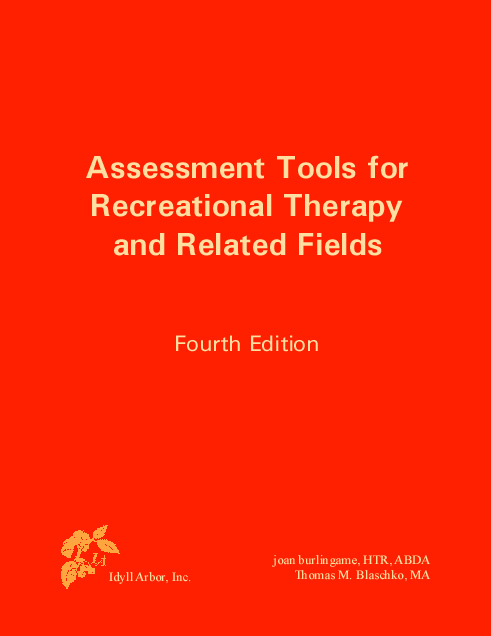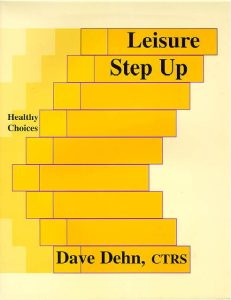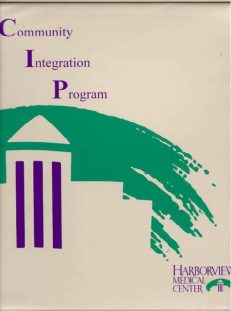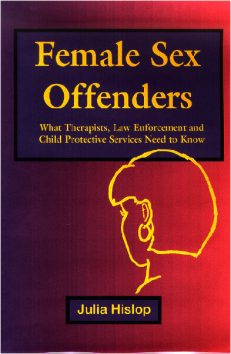Description
Since its first edition in 1990, this has become the standard reference book on assessment in Recreational Therapy. As with the earlier editions, the purpose of this book is to provide both the therapist and the student with specific, critical information about the assessment process, specific tools, and specific standards related to assessment. The information on national assessments, such as the RAI/MDS for long-term care, is especially important to therapists. The fourth edition has 726 pages with five new assessments and updated information on all national and international standards. This book is used in over fifty colleges and nine different countries!
Introduction 1
Assessment: Road Maps and Wild Cards 1
Note about Copyrights 2
Overview of the Contents 2
Part 1 Background Information 7
Assessment Basics 9
What is an Assessment? 9
Why Give Assessments? 10
Who Gives an Assessment? 10
Timing Considerations 10
Objective versus Subjective Information 10
Types of Assessment Tools 11
Nonstandardized Assessments 11
Standardized Assessments 14
Rapid Assessment Instruments 14
Signs 15
Scales 15
Summary 16
Assessment Theory and Models 17
Theory 17
Models 19
Test Structure 27
Statistics 28
Summary 34
History of Assessment in Recreational Therapy 35
Evolution of Evaluation 35
Hospital Recreation Assessments Prior to the 1950s 38
Recreational Therapy Assessments in the 1950s 39
Recreational Therapy Assessments in the 1960s 44
Recreational Therapy Assessments in the 1970s 46
Recreational Therapy Assessments in the 1980s 48
Recreational Therapy Assessments in the 1990s 50
Recreational Therapy Assessments in the 2000s 52
Protocols, Treatment Objectives, and Assessment 53
Integrating the FIM(R) Scale into Assessments 53
Troubling Patterns in Assessment 53
Where We Go From Here 54
Standards of Assessment 55
Regulatory Standards 56
Voluntary Standards 72
Professional Standards 73
Other Assessment Standards 75
Site-Specific Standards 82
General Guidelines for Writing Policies and Procedures 85
The Assessment Process 89
Assessments Prior to the Therapist’s Intake 90
Determining Which Clients Will Be Served by Recreational Therapy 91
Initial Screening for Services 92
Intake Assessment 92
The Interview Process 94
Initial Report and Treatment Plan 100
Clinical Opinion: The Most Frequently Used Assessment 102
Ongoing Assessment 103
Other Assessment Milestones 107
Closing Thoughts 109
Test Construction 111
Development of In-House Forms 112
Checklists 117
Observing Behaviors and Behavioral Observation 118
Developing Questionnaires 129
Translating Testing Tools into Different Languages 134
Other Testing Issues 135
Professional Competency Associated with the Assessment Process 135
Boundaries 139
When Tests are Computerized 143
Adapting Tests for Special Needs 144
Behaviors and Function that Impact Reliability of Test Scores 144
Cultural Issues with Tests 145
Trait versus State 149
Different Definitions of "Disability" 151
Documentation in Medical Charts 157
Basic Rules When Writing in a Chart 157
Documentation Related to the Initiation of Services 158
SOAP Notes 163
Establishing a Baseline for Treatment 164
Documenting Other Needs 166
Documentation Related to Ongoing Service Delivery 167
Considerations When Using Electronic Documentation 169
Politically Correct Terminology 169
Documenting on Sensitive Topics 169
Documentation on Discharge 171
Abbreviations 171
Conclusion 172
Part 2 Standardized Testing Tools 177
Signs and Scales 179
Signs 179
Scales 182
Measuring Attitudes 201
The Multiple Faces of Attitude 201
Leisure Categories: A Nonunified Approach 202
Cooperation and Trust Scale 204
Free Time Boredom 212
Idyll Arbor Leisure Battery 227
Leisure Attitude Measurement 231
Leisure Interest Measure 237
Leisure Motivation Scale 244
Leisure Satisfaction Measure 251
Second Page of the Assessments in the Idyll Arbor Leisure Battery 258
Leisure Diagnostic Battery 262
Leisurescope Plus 270
Life Satisfaction Scale 293
Measurement of Social Empowerment and Trust 297
Questions about Measuring Attitudes 303
Measuring Functional Skills 305
Standard Domains for Measurement of Function 305
Bus Utilization Skills Assessment 319
Comprehensive Evaluation in Recreational Therapy — Psych/Behavioral, Revised 326
Comprehensive Evaluation in Recreational Therapy — Physical Disabilities 337
FOX 346
Functional Assessment of Characteristics for Therapeutic Recreation, Revised 364
Functional Fitness Assessment for Adults Over 60 Years 376
Functional Hiking Technique 381
General Recreation Screening Tool (GRST) 390
Idyll Arbor Activity Assessment 399
Inpatient Rehabilitation Facility — Patient Assessment Instrument 416
Leisure and Social/Sexual Assessment 434
Measurable Assessment in Recreation for Resident-Centered Care (MARRCC) 447
Recreation Early Development Screening Tool (REDS) 460
School Social Behavior Scales, Second Edition (SSBS-2) 469
Home and Community Social Behavior Scales (HCSBS) 469
The Social Attributes Checklist — Assessing Young Children’s Social Competence 489
Therapeutic Recreation Activity Assessment 493
Other Tools that Measure Functional Skills 511
Questions about Measuring Function 515
Measuring Participation Patterns 519
Assessment of Leisure and Recreation Involvement 523
Leisure Assessment Inventory 539
Leisure Step Up 555
Recreation Participation Data Sheet 571
STILAP 578
Vitality Through Leisure 596
Questions about Measuring Participation 615
Community Integration Program 617
Community Integration Program 618
Overview 620
Populations 620
History of the CIP 620
Purpose of the CIP 621
Administration of the CIP 622
Community Environment Modules 623
Module 1A: Environmental Safety 624
Module 1B: Emergency Preparedness 637
Part 3 Measurements of Outcomes 641
Quality Assurance and Quality Indicators 643
Introduction 643
Quality Assurance 643
Interdisciplinary Assessments 646
Quality Indicators 647
Quality Measures 649
Overview of Federal Requirements 656
QI and Assistive Technology in Schools 663
Issues around QA and QI 663
Summary 665
Leisure Competence Measure 667
Background 668
Conceptualization of the LCM 669
The Need for Standardization 670
Psychometric and Measurement Considerations 671
Sensitivity to Diagnosis 671
Measuring Client Capabilities versus Actual Performance 671
Assessment versus Outcome Measurement 672
Resident Assessment Instrument and Minimum Data Set 677
The Resident Assessment Instrument 677
Historical Background of the RAI/MDS 679
Psychometric Properties of the MDS 680
RAI User’s Guide 682
Resident Assessment Protocols (RAPs) 694
Linking Assessment to Individualized Care Plans 704
MDS 3.0 706
References 709
Index 719






